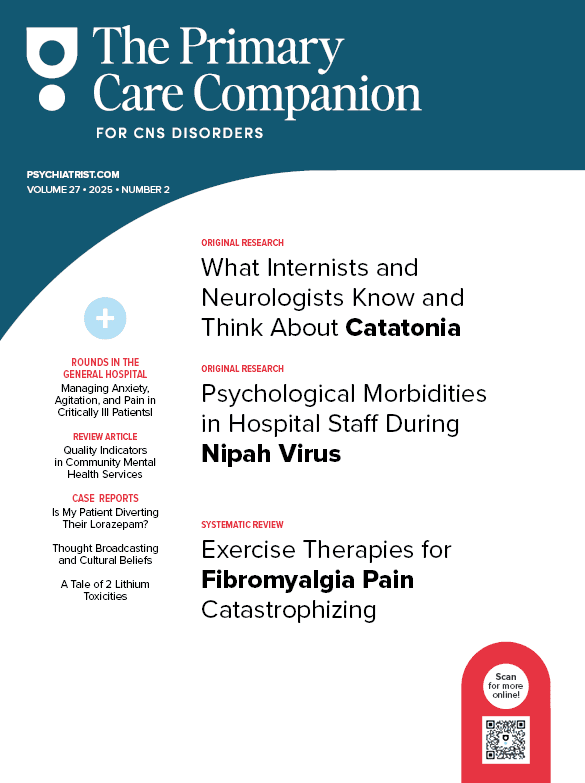See case report by Munipati et al
Letter to the Editor: Chronic benzodiazepine (BZD) use remains a public health problem worldwide despite recommendations of short-term use. This is clinically relevant given high potential for misuse, dependence, falls, and cognitive impairments with prolonged use.1 In North America, concurrent use of BZDs and opioids is of particular concern, as it leads to severe respiratory depression and contributes to opioid-related deaths.1,2 As a result, the US Food and Drug Administration has issued a warning against concurrent use of opioids and BZDs.3 However, theory and practice do differ. A recent US study4 found that 57% of all long-term BZD users were concurrently prescribed opioids. Among the biggest offenders were alprazolam, clonazepam, and lorazepam. In this sample, only 13% successfully discontinued BZD use after 1 year.4
A recent case report by Munipati et al5 illustrates the inherent difficulties of BZD discontinuation and reflects on the value of rapid versus slow tapering in the context of opioid maintenance. The case describes an adult male on buprenorphine maintenance with chronic illicit alprazolam use who completed a rapid BZD taper with adjunctive carbamazepine. While initial detoxification was successful, the patient was restarted on a BZD 7 months later. The patient was now under physician supervision with improved functioning, but the question remains whether this is the best outcome or reflects harm reduction.
In the context of opioid use, the ideal goal for BZD detoxification is complete and long-term cessation of BZDs with alternative ways to manage existing symptoms.3 However, it is easy for clinicians to become discouraged when attempting BZD tapers.1 In an effort to guide clinicians, a systematic review of 10 randomized controlled studies (N = 1,431) explored evidence on the feasibility of deprescribing BZDs. The review6 supports efforts of BZD deprescription (ie, “a clinician’s guided process of withdrawing inappropriate drugs”[p7]) and found that deprescribing was more successful when combined with nonpharmacologic support than it was with gradual taper alone. The clinical utility of such findings may depend on clarifying what kind of nonpharmacologic strategies are most effective. A complementary systematic review offers successful initiatives such as patient education and cognitive-behavioral therapy (CBT).7 CBT aims to help patients become aware of their own mindset and develop skills to respond to deprescribing challenges in an adaptive fashion.8
As patients struggle with physical and psychological dependence and clinicians grapple with discrepancies between their own practice and guidelines, it is clear that there is no simple answer to BZD deprescription.1 However, there are empirical data demonstrating that it is feasible to successfully deprescribe long-term BZDs.6 Further research should focus on developing best practices for patients with comorbid chronic BZD and opioid use including the integration of CBT and BZD tapering.3,7 Meanwhile, clinicians should weigh the risks and benefits of deprescribing with their patients and engage in multidisciplinary efforts to improve outcomes the best they can.
Dr Munipati and colleagues were shown the letter and declined to comment.
Article Information
Published Online: December 28, 2023. https://doi.org/10.4088/PCC.23lr03641
© 2023 Physicians Postgraduate Press, Inc.
Prim Care Companion CNS Disord 2023;25(6):23lr03641
To Cite: Modesto-Lowe V, Aurilio CN. Deprescribing benzodiazepines: is harm reduction enough? Prim Care Companion CNS Disord. 2023;25(6):23lr03641.
Author Affiliations: Hartford Behavioral Health, Hartford, Connecticut (Modesto-Lowe); Department of Psychiatry, University of Connecticut, Farmington (Modesto-Lowe); School of Health Sciences, Quinnipiac University, Hamden, Connecticut (Modesto-Lowe, Aurilio).
Corresponding Author: Vania Modesto-Lowe, MD, MPH, Hartford Behavioral Health, 2550 Main St, Hartford, CT 06120 (modesto-lowe@uchc.edu).
Relevant Financial Relationships: None.
Funding/support: None.
ORCID: Vania Modesto-Lowe: https://orcid.org/0000-0003-3036-2566
References (8)

- Modesto-Lowe V, Jain L, Rodrigues R. Benzodiazepine use: cross-national perspectives. Fam Pract. 2023;40(1):205–206. PubMed CrossRef
- Boon M, van Dorp E, Broens S, et al. Combining opioids and benzodiazepines: effects on mortality and severe adverse respiratory events. Ann Palliat Med. 2020;9(2):542–557. PubMed CrossRef
- Wang Y, Wilson DL, Fernandes D, et al. Deprescribing strategies for opioids and benzodiazepines with emphasis on concurrent use: a scoping review. J Clin Med. 2023;12(5):1788. PubMed CrossRef
- Gerlach LB, Strominger J, Kim HM, et al. Discontinuation of chronic benzodiazepine use among adults in the United States. J Gen Intern Med. 2019;34(9):1833–1840. PubMed CrossRef
- Munipati D, Mathur R, Sarkar S. Rapid detoxification in an adult with benzodiazepine dependence with the aid of an antiepileptic. Prim Care Companion CNS Disord. 2023;25(4):22cr03457. PubMed CrossRef
- Soni A, Thiyagarajan A, Reeve J. Feasibility and effectiveness of deprescribing benzodiazepines and Z-drugs: systematic review and meta-analysis. Addiction. 2023;118(1):7–16. PubMed CrossRef
- Dou C, Rebane J, Bardal S. Interventions to improve benzodiazepine tapering success in the elderly: a systematic review. Aging Ment Health. 2019;23(4):411–416. PubMed CrossRef
- Modesto-Lowe V, Kranzler HR. Diagnosis and treatment of alcohol-dependent patients with comorbid psychiatric disorders. Alcohol Res Health. 1999;23(2):144–149. PubMed
Please sign in or purchase this PDF for $40.




